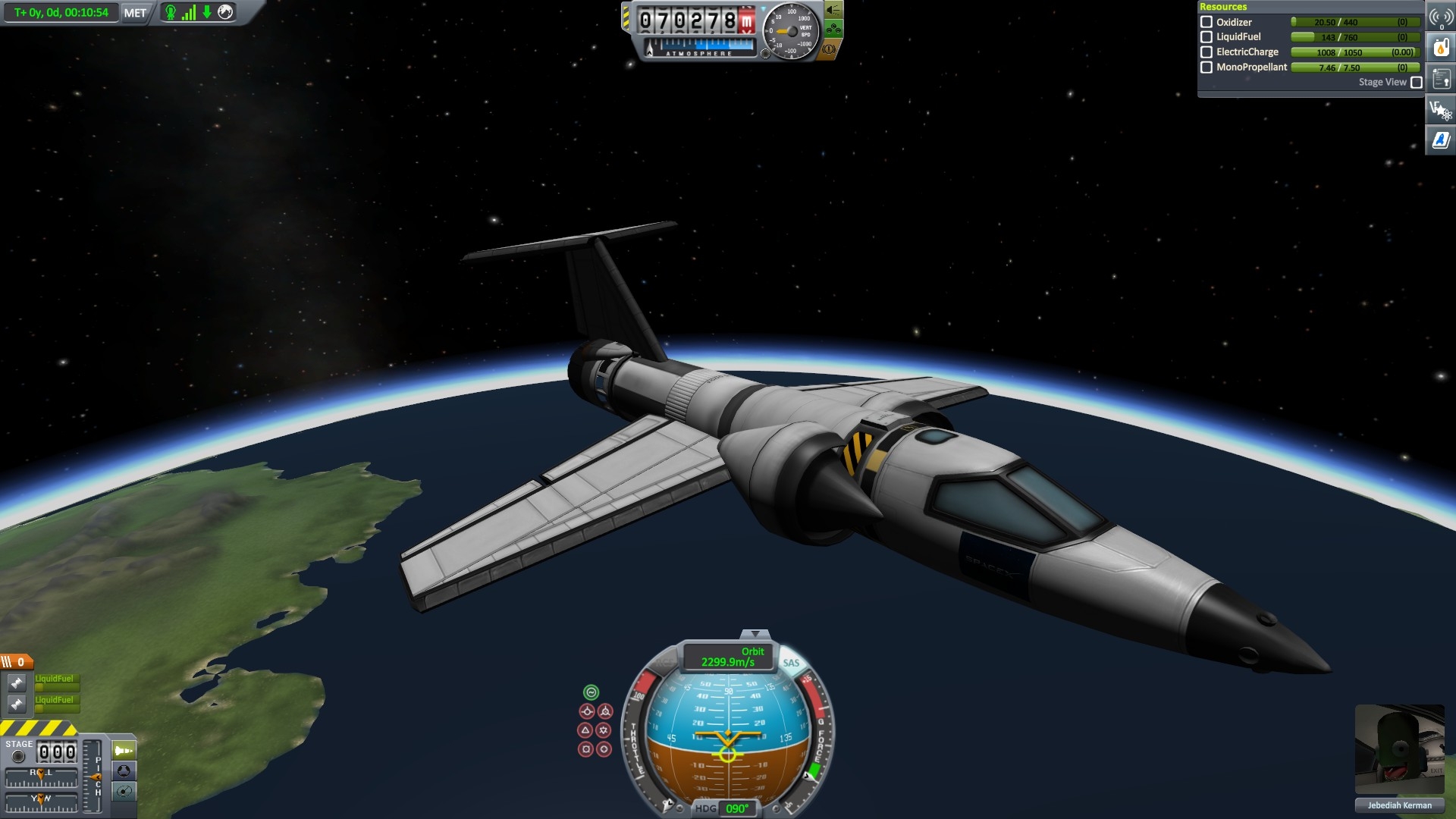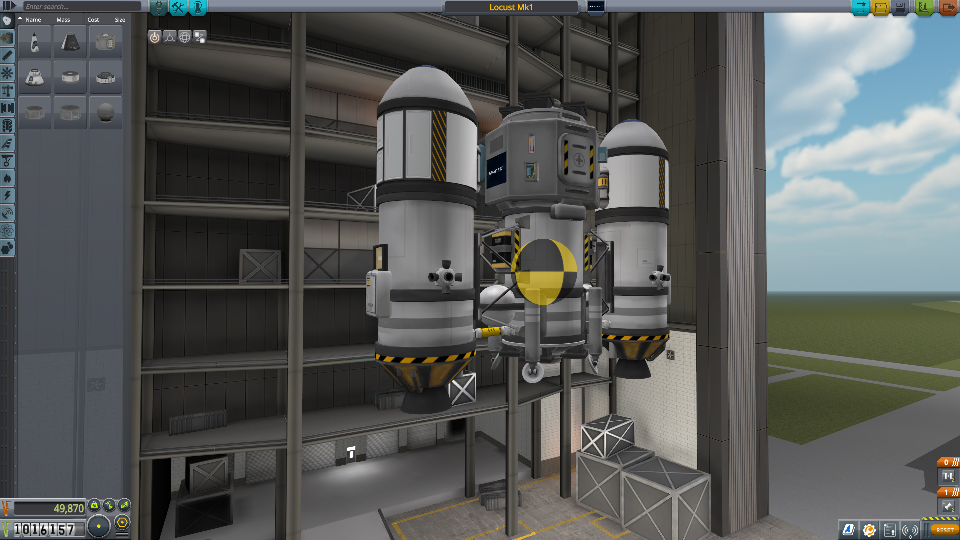I spent like 4 hours trying to get started in career mode. I've done all the science I can in the start and my only way to advance is to finally get out if low orbit. Which is what took the 4 hours, then promptly burned up on re-entry side I didn't have heat shields.
Spent the next hour rebuilding the rocket to include heat shields, then burned up again because I couldn't maneuver the capsule to put the shield down toward the heat.
Spent another hour digging around for my old joystick to "take this shit to the next level". Only to realize I suck controlling it with the joystick.
Then took all of 5 minutes to plug in my USB Xbox controller and do it flawlessly. Upper orbit, heat shield down, anddddd.... The rebuild put my parachutes on the wrong stage, so I hit the ground at 200kmph and exploded.
Took a break after that.
6 hours to gain the 5 science I didn't burn/explode.
I'd recommend using the starter capsule as your reentry vehicle for early career due to its built-in heatshield. By itself, it has no trouble doing ordinary entries and has plenty of space on the backshell for science instruments. Try targeting a perigee of 20 km - 30 km as well; shallower entries help a lot with entry heating/loading.
I got maybe 20 hours in the game, I finally did a successful orbit and re-entry. I burned up soooo many times, or slingshot myself out into empty space more times than I like to count.
@d3k0y said:
I got maybe 20 hours in the game, I finally did a successful orbit and re-entry. I burned up soooo many times, or slingshot myself out into empty space more times than I like to count.
You might consider turning down the difficulty settings while you're learning to play. Accurate drag, aerodynamics, and entry heating were all added to the game years after I started playing; after I'd already mastered the basics.
@RyanFodder noted after we finished up that I had no trouble controlling my vehicles while docking on RCS and not losing my bearings. A lot of that is practice but there's some stuff you can do to improve your play:
Ensure any RCS jets you place are equally spaced about your vehicle's center of gravity. There's a button in the hangar/assembly building that shows vehicle center of gravity like so:
The advantage of doing this is that it decouples translation from rotation such that using the H-N, I-K, J-L translation controls don't impart rotational forces though it's possible to meet this with asymmetric arrangements if you balance things such that the force multiplied by the lever arm (distance to CG) is equal.
Even if you don't have balanced RCS jets, using the "hold attitude" autopilot mode will fire additional jets to cancel rotational moments whenever translation is commanded. You saw me using this feature anytime I was flying the small capsule by itself as it doesn't have balanced RCS.
Most folks build symmetric spacecraft such that it might be difficult to tell which way is which at a glance. I add navigation lights to solve this issue. The international standard convention is green on the "right" side, red on the "left" side, like so:
I put a cross pattern of lamps around my spacecraft docking ports both to provide an alignment aid to get that nice right-angle orientation as well as to aid finding the port in the dark.
Right clicking on a docking port and selecting "Set this docking port as target" will let you get relative positioning from your spacecraft control point to that docking port.
While you can set your spacecraft control point to any docking port on it, I find that this can make things more challenging as it rotates the control axes to something other than the default vehicle axes. I prefer to locate my docking ports in fore/aft locations for my chaser spacecraft such that I don't have to move the control point or rotate the axis system. If you're slow and careful, you can eyeball docking port alignment for side-mounted docking ports without needing to change the control point.
Comments
http://gfycat.com/MajesticPlumpLacewing
And another bit of ridiculum:
https://gfycat.com/ClutteredSelfassuredEkaltadeta
I spent like 4 hours trying to get started in career mode. I've done all the science I can in the start and my only way to advance is to finally get out if low orbit. Which is what took the 4 hours, then promptly burned up on re-entry side I didn't have heat shields.
Spent the next hour rebuilding the rocket to include heat shields, then burned up again because I couldn't maneuver the capsule to put the shield down toward the heat.
Spent another hour digging around for my old joystick to "take this shit to the next level". Only to realize I suck controlling it with the joystick.
Then took all of 5 minutes to plug in my USB Xbox controller and do it flawlessly. Upper orbit, heat shield down, anddddd.... The rebuild put my parachutes on the wrong stage, so I hit the ground at 200kmph and exploded.
Took a break after that.
6 hours to gain the 5 science I didn't burn/explode.
I'd recommend using the starter capsule as your reentry vehicle for early career due to its built-in heatshield. By itself, it has no trouble doing ordinary entries and has plenty of space on the backshell for science instruments. Try targeting a perigee of 20 km - 30 km as well; shallower entries help a lot with entry heating/loading.
Version 1.1 (in testing) adds a bunch of new tutorial scenarios.

After a long hiatus, the KF-104A astronaut trainer takes to the stars again.

The 1.2 patch features reduced drag for streamlined bodies.
I got maybe 20 hours in the game, I finally did a successful orbit and re-entry. I burned up soooo many times, or slingshot myself out into empty space more times than I like to count.
You might consider turning down the difficulty settings while you're learning to play. Accurate drag, aerodynamics, and entry heating were all added to the game years after I started playing; after I'd already mastered the basics.
I've attached the environment for the EPIC 2017 tutorial; simply extract it to your KSP directory and have fun!
@RyanFodder noted after we finished up that I had no trouble controlling my vehicles while docking on RCS and not losing my bearings. A lot of that is practice but there's some stuff you can do to improve your play:
Ensure any RCS jets you place are equally spaced about your vehicle's center of gravity. There's a button in the hangar/assembly building that shows vehicle center of gravity like so:

The advantage of doing this is that it decouples translation from rotation such that using the H-N, I-K, J-L translation controls don't impart rotational forces though it's possible to meet this with asymmetric arrangements if you balance things such that the force multiplied by the lever arm (distance to CG) is equal.
Even if you don't have balanced RCS jets, using the "hold attitude" autopilot mode will fire additional jets to cancel rotational moments whenever translation is commanded. You saw me using this feature anytime I was flying the small capsule by itself as it doesn't have balanced RCS.
Most folks build symmetric spacecraft such that it might be difficult to tell which way is which at a glance. I add navigation lights to solve this issue. The international standard convention is green on the "right" side, red on the "left" side, like so:

I put a cross pattern of lamps around my spacecraft docking ports both to provide an alignment aid to get that nice right-angle orientation as well as to aid finding the port in the dark.
The lights for orientation is a good idea.
Your intuitive use of the keys I am quite jealous of.
One of these days, Alice. To the Mun!